This morning the alarm went off at 0500. It was still dark and we had a hard time getting up. We were out the door right at 0600, just after sunrise. We were on our way to the airport to pick up our friend, Mike, who was flying in from San Diego. Even though Heredia looks really close on the map, we were told it would be a 40 minute drive from the hotel.
On the way out of town, we did a quick drive up and down some of the more prominent streets to at least get a glimpse of this supposedly great city. As in most towns in Latin America, there is a large town square near a big church, but we didn’t see anything else that looked particularly historic or noteworthy. Heredia looks like an average town. We were literally the only car on the road. Ticos (Costa Ricans) must not like to go out early on Sunday mornings.
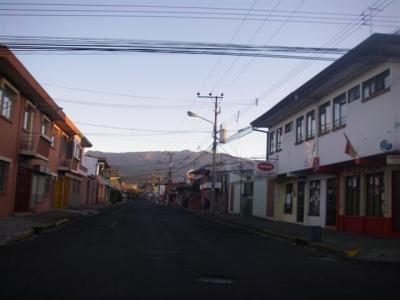
There is a two lane highway that connects Heredia to the airport. We found the road and headed out of town. On the outskirts of Heredia there were quite a few very nice, American suburb style homes on big lots. We also drove by a few track home developments in gated communities. As we traveled on, the rest of the road was an odd mix of residential and commercial/industrial. There were some really nice homes next to some scary looking industrial buildings that you would suspect might ooze toxic waste out of them. But, hey, maybe the house was there first.
We made it to the airport at 0615. We suppose that on weekdays during rush hour, traffic along this road is probably bumper to bumper, hence the 40 minute time estimate. The airport looks like every other major airport. We retrieved Mike and were quickly back on the road, heading northwest along a main highway. Mike brought us a new camera, which we are really excited about. We had looked all over Panama, but hadn’t been able to find a suitable water resistant model. Yay! No more blurry pictures!
Beyond the airport it is mostly industrial, then the farther you go the more residential it becomes. Gradually, it changes to a mix of residences and farms, and eventually becomes mostly undeveloped land with some farms and residences here and there. And, of course, we passed through a few small towns along the way. Once out of the industrial area, it is a scenic drive with lots of greenery. The forest areas are thick and lush. The cleared areas are fields of rolling hills with Kelly green grass. There was just a touch of fog, and the early morning light was hazy and soft, so in the cleared sections, it looked like England. Actually, it was quite foggy out, but somehow the fog level was always above our line of sight and we generally had a clear view of the road. The road is very nice and well maintained and it was a lovely drive. We still didn’t have a map and were driving by guesstimation.
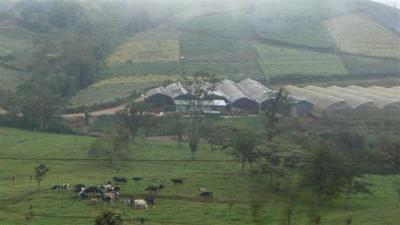
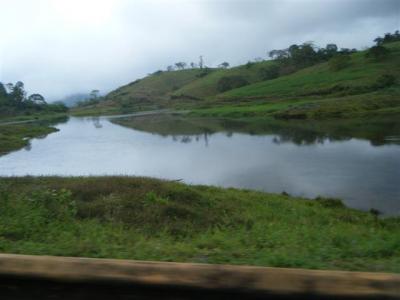
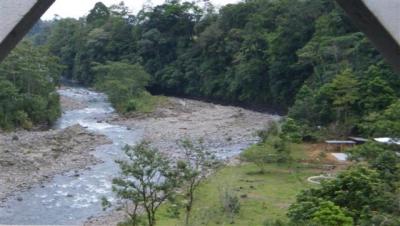
We had estimated the drive to La Fortuna would take 5 or 6 hours, so we were pleased when we pulled into downtown La Fortuna at about 0900. La Fortuna is another small, but spread out town, kind of like Golfito. Our hotel was a few miles beyond downtown. We were all instantly charmed by the hotel as soon as we saw it. It is a cluster of adorable little cabins with pretty tropical landscape, lots of exotic birds flitting about, and horses grazing on the grassy areas. We knew we’d likely be turned away, but we figured we may as well ask if we could check in early. The clerk said no problem. By 0930, we were in our cabin, enjoying the stunning view of the volcano across the road, and perusing all the tourist brochures we had picked up in the lobby to figure out what we were going to do while we were here.
The reason we had chosen this particular town is because Volcano Arenal is ranked as one of the most active volcanoes in the world. According to Lonely Planet, you can sit in your hotel room at night and watch the lava flow down the mountain. We were disappointed to find out that used to be true, but two years ago the lava flow had shifted direction and now goes down the opposite side of the mountain. Oh well. It is still a pretty view, even without the lava flow. The tip of it was completely enshrouded in clouds, and as the morning went on, we watched the cloud cover slowly burn away until almost the entire peak was visible.
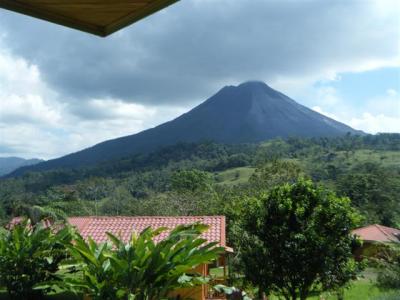
The clear view of the peak only lasted a few minutes, then the cloud cover came right back. By 1100, we had all our tourist activities lined up. The first thing on the agenda was lunch. We headed a little further out of town to a restaurant the hotel clerk had recommended. We all got casado plates. This time the side dishes were black beans, rice, a green salad, half a hard boiled egg, a piece of locally made cheese and a ripe fried plantain. We all got batidos for our beverages. We drank a lot of batidos in Panama, but we forgot to mention them. Batidos are basically what we call smoothies — fresh fruit blended up with sugar and milk (though you can get water instead of milk). Most restaurants have a big variety of fruits to choose from, such as pineapple, mango, papaya, etc, and some even offer mixed fruit batidos.
After lunch we joined a tour group. A small bus picked us up from the hotel and took us to a national park at the base of the volcano, not very far from the restaurant we had lunch at. As we were driving along, the tour guide suddenly told the bus driver to pull over. The tour guide had spotted a pack of coatis at the side of the road, and quickly ushered us out of the bus to get a look at them. It looked like there were nine of them in the pack, and they were not afraid of us. They seemed happy to pose for pictures.
The guide told us these were definitely females because the females live in packs with their young and the males are loners. He went on to tell us that Coatis eat just about everything and that they were sticking around in hopes we would feed them. Feeding them is illegal, but some people still do. Interestingly, Coatis are not nocturnal like most of the rest of the raccoon family.
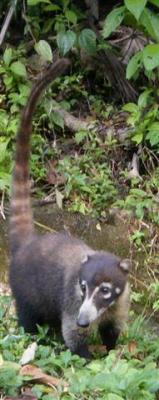
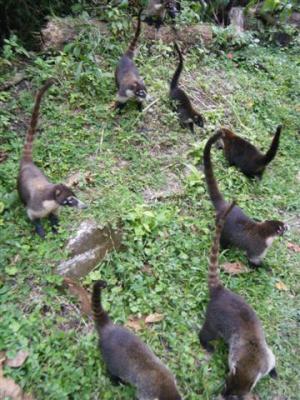
After a few minutes of fawning over the adorable little creatures, we piled back in the bus and in a few minutes arrived at the preserve. The parking lot we were dropped off in has a stunning view of the volcano and everyone stopped for photos before we started on the hike. While we were snapping away, the tour guide explained that Volcano Arenal was dormant until the July 1968. When it suddenly erupted, it wiped out a three towns around its base. Since then, the volcano has been consistently active, spewing and sputtering from one of three different craters. Which crater it spews from seems to shift every few years, hence the reason for the change in views from la Fortuna. Over the last 10 years the volcano has become less active, with less lava flow.
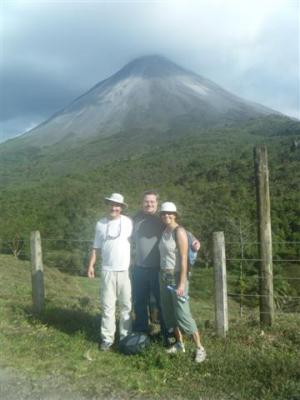
He also pointed out some craters in the ground near the parking lot and told us that the craters created by giant volcanic rocks that hit the ground during the 1968 eruption. Once we were done snapping photos, we set off down one of the many hiking trail. Our guide was excellent. He stopped and pointed out many of the trees, bushes and flowers that are indigenous to the area, telling us various information about each, such what they are used for. Some of the trees were so huge they were almost unreal, and they formed a canopy overhead that filtered out most of the sunlight. We saw several trees that had the cactus that looks like hair living on the branches. He also pointed out birds, animals, and assorted other critters in the forest and told us about them. Here is Mike, Christi and most of the tour group on the trail.
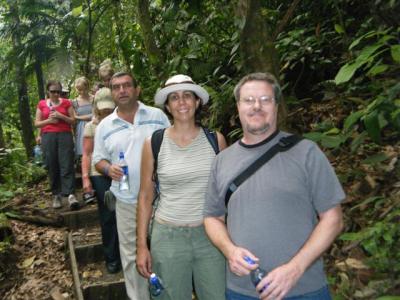
One of the species he dwelled on was the leaf cutter ants. When we saw them in Panama, we thought they were interesting, but after watching the demonstration of the ant’s strength, we now think they are amazing. Leaf cutters are definitely at the larger end of the ant spectrum in terms of overall size, but their heads are absolutely enormous, totally disproportional to the rest of their body. They also have mandibles that can carry a tremendous amount of weight in proportion to their own body weight. The guide picked up an ant and a stick. He got the ant to grab the stick with its mandibles and we watched in amazement as the ant held on to the stick for a long time. The stick was incredibly large and heavy for such a little guy, but he held on! We forget exactly how much weight he said they could hold, but it was an impressive number.
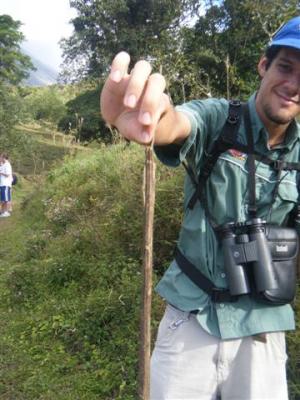
Our guide also pointed out a termite nest. As we mentioned, in our Indian River Nature Preserve post, termites sometimes build large nests inside living trees. The workers go out and consume cellulose, then come back to the nest and regurgitate the cellulose to feed the rest of the colony. Different species of termites get cellulose from different plants, but as we all know, dead wood is a common food source. The workers get in and out of the tree nest via a shallow tunnel dug under the tree bark. Interestingly, the termites have undeveloped eyes and are essentially blind, but they can sense light and don’t like it. Our guide figured out where the termite trail was and scratched off some of the bark, exposing the line of termites in transit. The termites went crazy, running for cover. The guide said that the termites were already at work building a new covered tunnel and within minutes would be done rerouting their trail and back to regular work. Likewise, if the nest somehow gets a hole in it, the colony will immediately repair it so the termites are back in the dark. Then the guide picked up a few of the fleeing termites and ate them. He tried to convince us all to taste one, too, but there was only one taker in the group, who said it didn’t really have much taste.
Amazingly enough, our guide spotted… to be continued..
